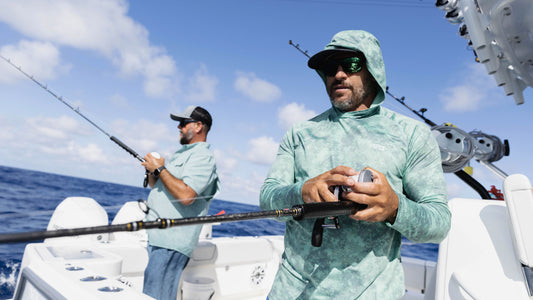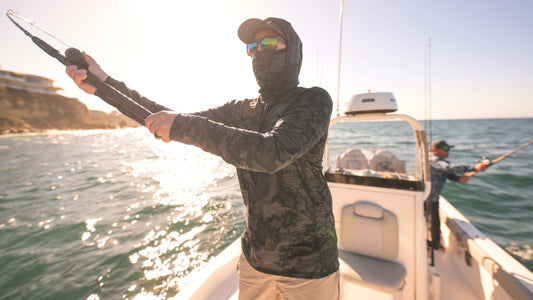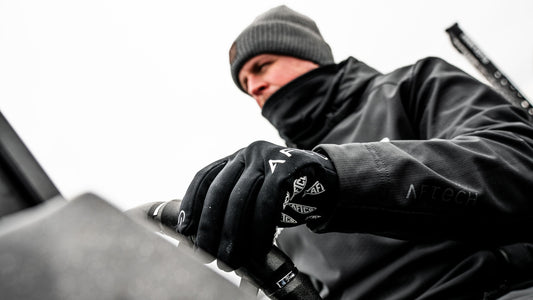
Tips for Fighting Big Fish
Fighting large fish differs based on the gear you are using as well as the technique you use to catch them. Here are a few techniques to help you catch bigger fish more.
Cranking Commercial Style for Big Fish
There are anglers who battle big fish by leaving the rod in a gunwale holder and simply cranking the reel. “It can be an effective method”, says AFTCO’s tackle brand manager Robby Gant. “People see commercial fishermen cranking in big fish that way and figure, hey, It works.” This does take a little bit of fun away from a fight though (and by the way immediately disqualifies any potential world record from consideration). “It’s less you doing it than the boat,” Gant suggests. "It is very effective though and has a time and place". With other strategies you will be able to use the same rod you usually would use, but with this technique you will want a dedicated rod with a bent butt because a regular straight butt rod will create a bad angle when fighting a big fish and you run the risk of breaking the rod. What you will want to use is a bent butt or a curved butt that will keep your rod at the perfect angle to fight a fish from any angle within the gunwale holder. A good example of these are the AFTCO unibutts in curved sizes. They can be found from physical and online retailers such as Mudhole Tackle.

Using a Rod Belt to Fight Big Fish
The easiest and least complicated approach to fighting fish is simply to hold the rod butt against your upper thigh, pull on the rod, and reel in line as you’re able. But simplest isn’t always best. Using a rod belt (a.k.a. fighting belt) can give the angler an immediate edge. A harness steps up to another level an angler’s ability to take on a large fish.
“The only time I don’t use a belt, and — often — a harness,” Gant says, “is when fighting smaller fish” that come in pretty easily. “Most boats will have at least a belt on board,” Gant says. “As soon as a fishermen is struggling for a while to get a fish to the boat, the belt comes out.” A good belt helps anglers fight fish in several ways, among them the protection against rod-butt bruising. Gant points out that a belt spreads out the stress over a larger area of the angler’s body rather than a single pressure point on the angler’s thigh. Having the rod’s butt in a belt also allows an angler in a prolonged fight to concentrate on the battle, and not having to keep moving the rod butt to find a new spot, not yet sore.

One tip to picking a belt, Gant recommends, “bigger is better” with larger belts, such as AFTCO’s Vallarta XL, Socorro and Clarion XL, distributing the load more effectively. Another benefit to these larger belts are that they don’t slide on an angler’s body as much as smaller belts.
When to Use a Harness on Big Fish
With large or difficult fish, it’s time to step up the tactics a notch and slip into a harness. Yellowfin and bluefin tuna are poster children for harness use. Rather than simply rely on your arms to pull on a big fish, a good harness-and-belt rig is suddenly using the body, particularly the legs to gain lift on the rod each stroke. A harness isn’t just for big fish, Gant points out. “For any long-duration battle, a harness comes into play,” he says. Thus anglers fishing light tackle and hooking fish large enough to result in a prolonged fight can avoid tiring easily by using a harness.
Gant suggests that an angler clipping into a harness, for example, AFTCO’s Maxforce harness, matched with a wide belt can (1) take a lot of pressure off the angler’s body and (2) allow the angler to exert far more pull on a fish than by simply pulling on the rod with his or her arms. The harness allows the angler to squat repeatedly and employ the legs — stronger than arms alone — in the effort. At the same time, the pressure on an angler’s back is reduced. “Guys fighting fish without a harness often complain of back pain,” he says. “Your posture is more correct while fighting fish in a harness,” which minimizes pressure on one’s back.
For more tips, look at the How to Choose a Fishing Fighting Belt and Proper Fit of a Fishing Fighting Belt Blog.

What About Spinning Gear?
Harnesses are designed to clip to conventional reels. But what if you’re using heavy spinning gear? (And it’s worth noting that these days, high-quality heavy spinning tackle is designed to handle up to 80-pound braided line or heavier, with max drags settings in some reels exceeding 50 pounds. Couple that kind of gear with big tuna or amberjack and the like, and a harness becomes invaluable. Traditionally, harnesses have been of little use for spinning enthusiasts, but AFTCO changed that with its unique Spin Strap. The simple strap goes around the rod at the upper reel foot then the ring at each end of the strap are attached to a harness via the harness hooks on each side. At that point, an angler gains the ability to use his legs and body in the fight, as with conventional gear, squatting to load the rod and winding line as he stands upright.

Rail-Rodding for Fighting Big Fish
The rail rod technique has become popular in the Southern California fisheries where the sportboats have high gunwhales and the rod can be leaned on them, but the technique has also expanded to private boaters alike. Gant explains that anglers place the foregrip of the rod against the high rail, so it acts as a fulcrum, keeping most of the pressure on the rail. “In some cases, an angler can put the butt of the rod under his arm, almost fighting on his knees,” he says. Gant does mention a mistake he commonly sees among anglers rail-rod fishing. “Some guys get a bite and go directly to the rail. But when the fish is still out in front of you, vs. essentially below you, rail fishing doesn’t really work. You need to stand-up fight until the fish is mostly underneath the boat, then go to the rail.”

While the method is effective, the International Game Fish Association's rules for potential world records specify stand up fishing methods only meaning any potential record fish could not be considered using this method either.



